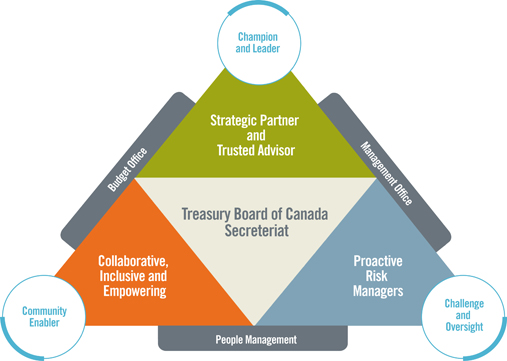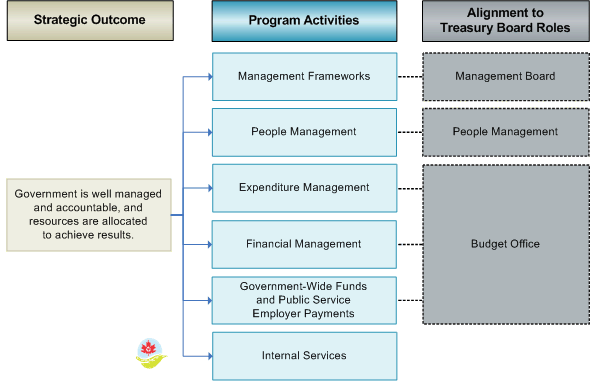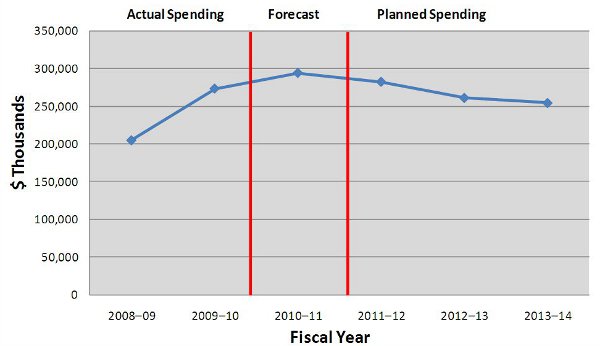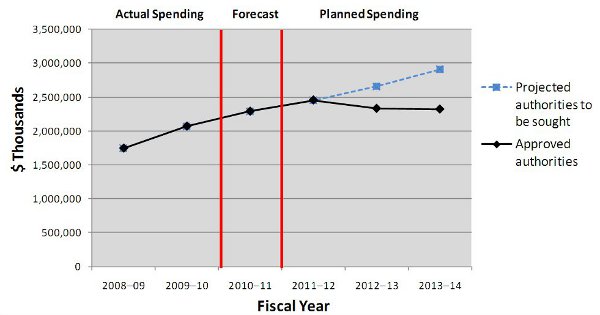Common menu bar links
Breadcrumb Trail
ARCHIVED - Treasury Board of Canada Secretariat - Report
 This page has been archived.
This page has been archived.
Archived Content
Information identified as archived on the Web is for reference, research or recordkeeping purposes. It has not been altered or updated after the date of archiving. Web pages that are archived on the Web are not subject to the Government of Canada Web Standards. As per the Communications Policy of the Government of Canada, you can request alternate formats on the "Contact Us" page.
President's Message
I am pleased to present the 2011–12 Treasury Board of Canada Secretariat's Report on Plans and Priorities. This report sets out the Secretariat's plan to support the Government of Canada and its employees in meeting the priorities of Canadians.
During the recent global recession, the Secretariat helped Canada's economic recovery by implementing Canada's Economic Action Plan quickly and responsibly. Our focus has now shifted to controlling the growth of Government spending and balancing the budget by 2014–15.
At the same time, we are working to improve the services that the Government provides to Canadians by modernizing how government works, renewing our workforce and workplace and managing our people effectively.
As we move forward, we will continue to ensure that the right mix of policies for managing Government, human resources and budgeting are in place to efficiently continue to support ongoing economic growth, job creation and a return to balanced budgets.
I invite all Canadians, through this report, to see how the Treasury Board Secretariat plans to achieve its objectives in the year to come.
The Honourable Tony Clement
President of the Treasury Board and Minister for the Federal Economic Development Initiative for Northern Ontario
Section I: Departmental Overview
Raison d'être
The Treasury Board of Canada Secretariat (the Secretariat) is the administrative arm of the Treasury Board. It supports Treasury Board ministers and strengthens the way government is managed to ensure value for money in government spending and results for Canadians.
Responsibilities
Treasury Board Roles
The Treasury Board is a Cabinet committee of ministers invested with a broad range of responsibilities for management excellence, policy development, and budget oversight. As general manager of the public service, the Treasury Board's three main roles are as follows:
- It is the government's management board, responsible for promoting improvement in management performance, developing policies and priorities to manage government assets and resources, and overseeing the government's regulatory function.
- It is the government's budget office, responsible for examining and approving the proposed spending plans of government departments and agencies and for financial management and reporting.
- It is responsible for people management and is the employer of the core public administration.
The Secretariat makes recommendations and supports the Treasury Board in each of its roles (see text box "Treasury Board Roles") by providing advice on policies, directives, regulations, and program spending to promote sound management of government resources. The Secretariat also provides leadership and guidance on management functions within departments and agencies, while respecting the primary responsibility of deputy heads in managing their organizations and their role as accounting officers to Parliament.
Within the Secretariat, the Comptroller General of Canada provides government-wide leadership, direction, oversight, and capacity building for financial management, internal audit, and acquired services and assets management. The Chief Human Resources Officer leads people management across the federal public service by developing workplace policies, centrally managing labour relations, compensation, and pension and benefit plans, and developing executive leadership. The Chief Information Officer provides government-wide strategic direction and leadership for information management and information technology (IM/IT), including identity management, security, and access to information and privacy.The Treasury Board Portfolio consists of the Secretariat and the Canada School of Public Service. The Public Service Pension Investment Board, the Office of the Commissioner of Lobbying of Canada, and the Office of the Public Sector Integrity Commissioner report to Parliament through the President of the Treasury Board.
When working with federal departments, agencies, and Crown corporations, the Secretariat plays three central agency roles:
- An enabling role to help organizations improve management performance;
- An oversight role that includes developing policies and standards and reporting on the government's overall management and budgetary performance; and
- A leadership role in driving and modelling excellence in public sector management.
Through legislation such as the Federal Accountability Act,[i] as well as through the renewal of the Treasury Board policy suite, greater emphasis has been placed on the Secretariat's enabling role—helping deputy heads maximize their flexibility to achieve management excellence within their organizations.
The following diagram depicts how the Secretariat fulfills its three central agency roles and how it supports the Treasury Board.
How the Secretariat Works with Organizations

Strategic outcome and program activity architecture
All of the Secretariat's efforts and activities are guided by its strategic outcome:
Government is well managed and accountable,
and resources are allocated to achieve results.
The following diagram illustrates the strategic outcome and program activities that make up the Secretariat's program activity architecture (PAA). The PAA captures all the program activities that contribute to achieving the Secretariat's strategic outcome. The diagram also demonstrates the link between the PAA and the Secretariat's three key roles. The Secretariat's strategic outcome and each of its program activities are presented in greater detail in Section II.
2011–12 Program Activity Architecture

![]() This symbol indicates that through the Internal Services program activity, the Secretariat contributes to the Federal Sustainable Development Strategy (FSDS), specifically to Theme IV: Shrinking the Environmental Footprint—Beginning with Government.
More information on the Secretariat's contribution to the FSDS is provided in the upcoming sections.
This symbol indicates that through the Internal Services program activity, the Secretariat contributes to the Federal Sustainable Development Strategy (FSDS), specifically to Theme IV: Shrinking the Environmental Footprint—Beginning with Government.
More information on the Secretariat's contribution to the FSDS is provided in the upcoming sections.
Planning summary
The following tables present the total financial resources (i.e., total planned spending) of the Secretariat for the next three fiscal years. This does not include centrally managed funds used to supplement other appropriations that are displayed in the Main Estimates (see "Estimates by Vote and Statutory Item" in Section I).
Financial resources[1]
| 2011–12 | 2012–13 | 2013–14 |
|---|---|---|
| 282,424 | 261,021 | 254,354 |
| 2011–12 | 2012–13 | 2013–14 |
|---|---|---|
| 2,452,225 | 2,328,354 | 2,318,396 |
Human resources
| 2011–12 | 2012–13 | 2013–14 |
|---|---|---|
| 2,216 | 2,151 | 2,068 |
This table presents a summary of the total planned human resources for the Secretariat for the next three fiscal years. Human resources are presented as the number of full-time equivalents (FTEs).
Planning summary table
| Performance Indicator | Target |
|---|---|
| Canada's ranking in The World Bank Worldwide Governance Indicators,[ii] indicator 3 "Government Effectiveness." | Top 10 among Organisation for Economic Co-operation and Development member countries (annually). |
| Program Activity | Forecast Spending 2010–11 |
Planned Spending | Alignment to Government of Canada Outcomes | ||
|---|---|---|---|---|---|
| 2011–12 | 2012–13 | 2013–14 | |||
| Management Frameworks | 70,098 | 73,043 | 63,132 | 63,132 | Government Affairs: "Well-managed and efficient government operations."[iii] |
| People Management | 66,375 | 59,541 | 57,833 | 51,939 | |
| Expenditure Management | 37,697 | 36,312 | 35,387 | 35,387 | |
| Financial Management | 34,837 | 33,057 | 26,467 | 26,467 | |
| Internal Services | 85,193 | 80,471 | 78,202 | 77,429 | N/A |
| Sub-Total | 294,200 | 282,424 | 261,021 | 254,354 | N/A |
| Government-Wide Funds and Public Service Employer Payments | 2,287,114 | 2,452,225 | 2,328,354 | 2,318,396 | Government Affairs: "Well-managed and efficient government operations." |
| Total Planned Spending | 2,581,314 | 2,734,649 | 2,589,375 | 2,572,750 | N/A |
Operating environment
While governments are continuously under pressure to respond to changing economic circumstances and social demands, at no time in recent history has this been truer than today. The global financial crisis has had a profound impact on the Canadian economy and society. Through its Economic Action Plan, the government introduced timely, targeted, and temporary stimulus to limit the severity of the economic downturn in Canada.
The government has now shifted its focus to the need for fiscal restraint and a return to balanced budgets. Eliminating the deficit will require attention, careful management, and application of the full range of tools at the government's disposal.
At the same time, public sector management in Canada will have to respond to the effects of an aging and increasingly diverse population, compounded by the expected exodus of baby boomers from the workforce. Through the Secretariat, the government is already taking action to renew its workforce, as well as modernize its approach to people management.
The imperative to continually improve effectiveness and efficiency, along with the evolution of new technologies and business practices, is changing the way government delivers programs and services. This includes looking at ways to reduce the administrative footprint of government and at the same time improve service to Canadians.
There is continuous need to reduce red tape in order to reduce the compliance burden on business and the administrative cost of government. In addition, technological advancements and the increasing interconnectedness of society are contributing to a growing public desire for more open and accessible government.
Priorities
The 2011–14 priorities for the Secretariat were informed by its 2010 Strategic Reviews,[iv] the opportunities and challenges of its operating environment, as well as potential corporate risks (see "Risk analysis" in Section I).
Three strategic priorities and two management priorities have been identified to drive progress toward the Secretariat's strategic outcome during the 2011–14 period. Priorities will be supported by the Secretariat's program activities, including a range of specific initiatives that are further described in Section II.
Strategic priorities for the 2011–14 period
| 1. Support the government in ensuring value for money and sound financial management | |
| Ongoing priority | This priority is supported by results under the Expenditure Management and Financial Management program activities. |
Why is this a priority?
Ensuring value for money in government programs, services, and operations and ensuring sound management and accountability for government resources are essential components of the government's plan to return to balanced budgets.
Plans to support this priority:
- Continue to guide the implementation of government cost containment measures.
- Launch the second cycle of Strategic Reviews[iv] of government spending.
- Support deputy heads in implementing improvements to financial systems and reporting, and build capacity in the financial management community.
| 2. Advance initiatives to modernize government operations | |
| Ongoing priority | This priority is supported by results under the Management Frameworks, People Management, and Financial Management program activities. |
Why is this a priority?
To continually improve the effectiveness and efficiency of government operations, administration, and services requires continually reviewing and improving business and management approaches and practices. In this context, the Secretariat is advancing initiatives to modernize government infrastructure, streamline rules, and harmonize business processes and systems.
Plans to support this priority:
- Implement initiatives to reduce red tape, including supporting the work of the Red Tape Reduction Commission.[v]
- Support the government's efforts to consolidate internal and external services and standardize government business processes, including financial business processes.
- Provide direction for a more strategic, government-wide approach to IM/IT management, infrastructure, and investments.
| 3. Crystallize and implement the new approach to people management | |
| Ongoing priority | This priority is supported by results under the People Management program activity. |
Why is this a priority?
The federal public service is a large and diverse national institution. In recent years, the government has made significant changes to its approach to people management, including creating the Office of the Chief Human Resources Officer within the Secretariat, passing the Public Service Modernization Act,[vi] and promoting the shift to a risk-based management approach. While much progress has been made, work remains to crystallize this new approach.
Plans to support this priority:
- Support deputy heads in implementing better and standardized human resources (HR) processes and systems.
- Develop a comprehensive approach to compensation.
- Consider and address the results of the legislative review of the Public Service Modernization Act.
Management priorities
| 1. Pursue continuous improvement of the operations of the Secretariat | |
| Ongoing priority | This priority is supported by results under the Internal Services program activity. |
Why is this a priority?
In 2010–11, the Secretariat undertook a Strategic Review Process[iv] that challenged it to examine all of its activities and spending, and identify ways to further increase efficiency and effectiveness in meeting the priorities of Canadians. Implementing the results of the strategic review will be a three-year process requiring focused attention and resources. In this context, the Secretariat will continue to seek opportunities to further increase the efficiency and effectiveness of its internal operations.
Plans to support this priority:
- Effectively manage implementation of the Secretariat's strategic review results over a three-year period.
- Strengthen integrated planning within the Secretariat by moving to a more strategic
three-year planning horizon. - Continue to identify ways to improve efficiency and effectiveness within the Secretariat.
- Develop a long-term accommodations plan that includes plans to renew the Secretariat's workplace.
| 2. Embed the role of the Secretariat as an enabler, and simplify the oversight function | |
| Ongoing priority | This priority is supported by all of the Secretariat's program activities. |
Why is this a priority?
As a result of the Federal Accountability Act,[i] as well as Treasury Board's policy suite renewal,[vii] deputy heads of departments and agencies are now vested with clearer accountabilities and greater management flexibility. For this reason, the Secretariat will place greater focus on its enabling role, improving support to deputy heads, and simplifying the oversight function to promote flexibility, accountability, and results.
Plans to support this priority:
- Use feedback from departments and agencies to strengthen the Secretariat's internal capacity to carry out its enabler role.
- Make more effective use of existing data to enable oversight activities.
- Support departmental implementation of policies and initiatives, including capacity building across government.
Risk analysis
The Secretariat actively monitors its operating environment in order to identify and manage risks that could affect progress toward its strategic outcome. Key risks are captured in the Secretariat's corporate risk profile, which is updated at least once per year. The Secretariat has identified a number of key corporate risks for 2011–12, grouped into two categories: risks affecting the Secretariat's central agency functions and departmental risks related to its internal operations.
Central agency risks
Two key central agency risks have been identified. The first of these is related to a shift in the roles and responsibilities of the Secretariat (toward an enabling role) and deputy heads (to clearer accountability). This risk reflects the complexity associated with the evolving enabling role of the Secretariat as envisaged in the Federal Accountability Act[i] and policy suite renewal,[vii] as well as uncertainty around how deputy heads will embrace their new accountabilities over time. This risk is particularly relevant to the Management Frameworks program activity.
The second risk is related to the increasing number and range of cost containment measures and how these interact with and affect the integrity of government operations and the management capacity of departments and agencies. This risk is particularly relevant to the People Management and Expenditure Management program activities.
Strategies to mitigate central agency risks include continuing implementation of the renewed policy suite, strengthening policy monitoring and oversight, exercising expenditure management controls over departmental operating budgets, supporting stability in compensation through early engagement of bargaining agents, and engaging deputy heads in regular discussions to ensure coherent resource management across government.
Departmental risks
Like many organizations, the Secretariat faces challenges and risks related to its aging information technology infrastructure and the need to safeguard information against ever-changing security threats. The Secretariat also manages risks involved in implementing its recent significant organizational changes and in enhancing its preparedness for emergency situations. These departmental risks are relevant to the Internal Services program activity (see "Program Activity 6: Internal Services" in Section II).
Strategies to mitigate these risks include completing the relocation of the Secretariat's data centres, finalizing a Disaster Recovery Plan, implementing the next phase of the IM/IT Security Action Plan, and developing an Emergency Management Plan.
Contribution to the Federal Sustainable Development Strategy
As with other departments and agencies, the Secretariat contributes to the Federal Sustainable Development Strategy (FSDS), through which environmental sustainability has become an integral part of the government's planning and reporting processes. The Secretariat contributes by reducing the environmental impact of its internal operations and thus helps to shrink the overall environmental footprint of government (FSDS, Theme IV). Details on the Secretariat's activities to support sustainable development can be found in Sections II and III. For a full discussion of the FSDS, please consult the Environment Canada[viii] website.
Expenditure profile
For fiscal year 2011–12, the Secretariat's total available funding in the Main Estimates is $5.88 billion. This includes centrally managed funds, in the amount of $3.16 billion, used to supplement other appropriations of departments. The Secretariat's planned spending, not including centrally managed funds, is $2.73 billion.
The bulk of the planned spending ($2.45 billion) is related to the Secretariat's role as employer of the core public administration. These funds are used for the following:
- The public service pension, benefits, and insurance, including payment of the employer's share of health, income maintenance, and life insurance premiums;
- Payments to or in respect of provincial health insurance;
- Payments of provincial payroll taxes and Quebec sales tax on insurance premiums;
- Costs associated with the pension, benefit, and insurance plans for employees engaged locally outside Canada; and
- The return to certain employees of their share of the employment insurance premium reduction.
The remaining planned spending ($0.28 billion) is directly related to the operations of the Secretariat and its five other program activities: Management Frameworks, People Management, Expenditure Management, Financial Management, and Internal Services.
2011–12 Planned Spending

Departmental spending trend
The following illustrates the Secretariat's spending trend from 2008–09 to 2013–14 for the operations of the Secretariat and its five other program activities: Management Frameworks, People Management, Expenditure Management, Financial Management, and Internal Services. These operations reflect the people and activities that support the Secretariat's strategic outcome of ensuring that government is well managed and accountable and that resources are allocated to achieve results.
Spending Trend for Program Expenditures (Vote 1)*

* Includes Employee Benefit Plan
The Secretariat's spending increased in 2010–11 compared with 2009–10 due to the funding received to implement the following initiatives:
- Financial Interoperability and Stewardship Initiative;
- Canada's Cyber Security Strategy;
- Red Tape Reduction Commission;
- Establishment of a litigation management unit within the Secretariat to manage employment and labour relations litigation; and
- Support to the ongoing management of the classification program for the core public administration.
The Secretariat's spending will decrease between 2011–12 and 2013–14 due to the sunsetting of funds for various initiatives within the Secretariat.
Spending Trend for Public Service Insurance (Vote 20)

Expenditures in public service insurance include the payment of the employer's share of insurance plans, employment insurance, and other related expenses.
Public service employer payments are increasing from 2008–09 as a result of growth in the government-wide wage envelope, growth in the public service, and cost of benefits under the plans. Planned spending amounts for 2012–13 and 2013–14 reflect currently approved funding and do not reflect forecasted spending of $2.65 billion and $2.91 billion respectively. The expenditures under Treasury Board central Vote 20, which reflect the cost of Public Service Insurance plans, are projected to increase as a result of continued demographic pressures, the increased usage of services and prescription drugs, as well as the growing per-unit cost of drugs and services. Treasury Board approval to increase funding for these years will be sought by 2012–13.
Estimates by vote and statutory item
For information on votes and statutory expenditures, please see the 2011–12 Main Estimates publication. An electronic version of the Main Estimates is available at http://www.tbs-sct.gc.ca/est-pre/2011-2012/me-bpd/info/info-eng.asp.
